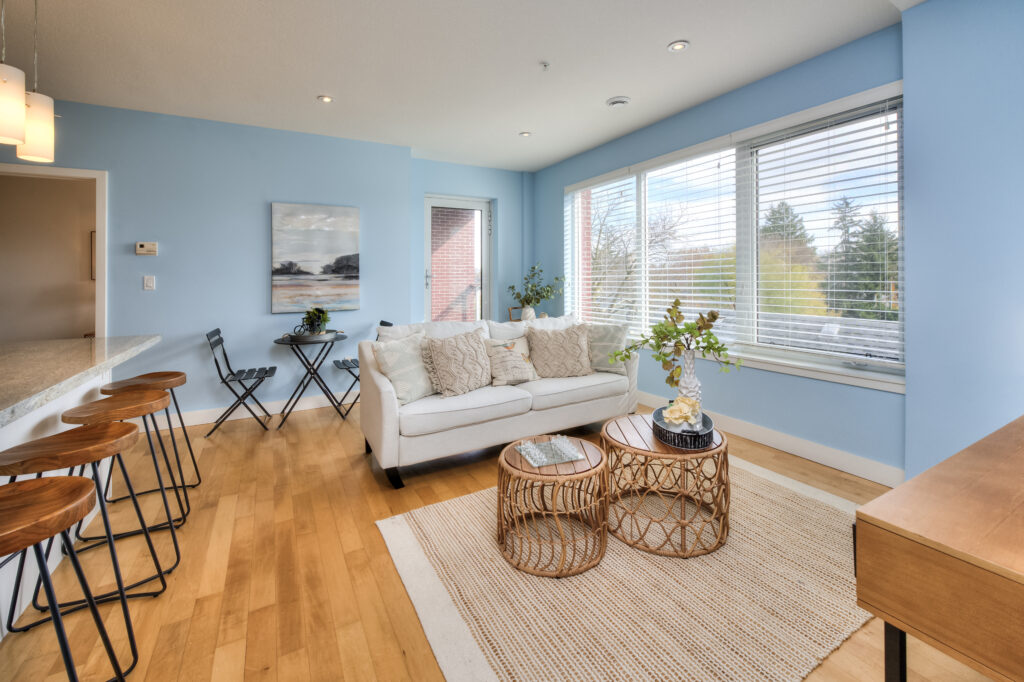
Selling a vacant property presents unique challenges. An uninhabited house can often seem uninviting and impersonal, making it difficult for potential buyers to envision it as a home. Transforming these empty spaces into warm, inviting homes that buyers can fall in love with requires expertise and a keen eye for design. Here’s how to tackle the void and turn it into a sale-ready property.
The Challenge of the Void
The emptiness of a vacant property can unintentionally underscore its flaws and make it seem less appealing. A space without furnishings or decor lacks reference points that can convey size and potential, often leading to a lower perceived value.
Defining the Empty Space

(A before-and-after bedroom staged by Helen’s Design.)
Staging begins with defining the space to show its potential. Carefully chosen pieces suggest how each area can be utilized, making it easier for buyers to imagine their life unfolding within the walls.
The Importance of Lighting
Capitalizing on lighting to enhance the mood and feel of each room is crucial, utilizing natural light and supplemental fixtures to create a bright, welcoming environment.
Dealing with Acoustics and Echoes
Strategic placement of textiles and furniture can soften sound and add a layer of coziness to the atmosphere, addressing the issue of echo commonly found in vacant properties.
Strategic Staging Techniques
Strategy #1: Define the Space

(A before-and-after living room/kitchen staged by Helen’s Design.)
Staging your home with furniture that illustrates the functionality of each space is key. This helps potential buyers visualize the purpose of each area within the house.
Strategy #2: Focus on Key Rooms
Prioritizing rooms that make the most significant impact on purchasing decisions is essential. Staging the living room, kitchen, and master bedroom can influence buyers’ perception more profoundly.
Strategy #3: Use Minimalism to Your Advantage
A minimalist approach to staging can highlight the home’s best features with a few well-chosen pieces, showcasing the property’s potential without clutter.
Adding Warmth and Character
Strategy #4: Create Warmth
Using accessories like area rugs, throw pillows, and throws can add warmth and texture, making a space feel more approachable and comfortable.
Strategy #5: Illuminate the Space
Ensuring every room is lit to showcase its full potential can dramatically change the feel of the space, from cold to cozy.
Addressing Imperfections and Details
Strategy #6: Address Imperfections
Without the distraction of personal items, minor flaws become apparent. Touching up paint, repairing damage, and ensuring a spotless presentation are critical steps in staging an empty house.
The Finishing Touches
Strategy #7: A Touch of Life
A little greenery can go a long way in adding vibrancy and appeal to a property. Staging with plants and fresh flowers suggests a lived-in and loved atmosphere.
Embracing Technology in Staging
The Virtual Alternative
For those seeking a more tech-savvy staging solution, virtual staging can provide an economical and swift option, offering an idealized vision of the property furnished.
Wrapping Up

Staging an empty house is more than filling space with furniture—it’s about curating an environment that resonates with buyers and paints a picture of a home filled with warmth and possibility. If you’re looking to present your property in its best light, our services at Helen’s Design can guide you to a successful sale. We’re dedicated to showcasing your home’s true potential and making that all-important first impression count.
To discover more about our bespoke staging services and how we can assist in preparing your property for the market, reach out to us for a consultation. Let’s turn your vacant property into the next buyer’s dream home.
